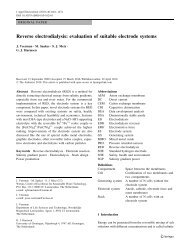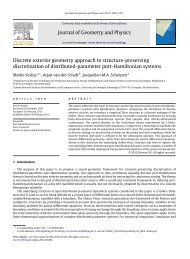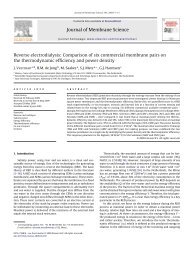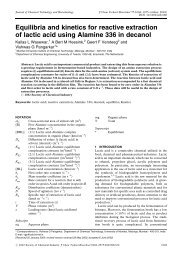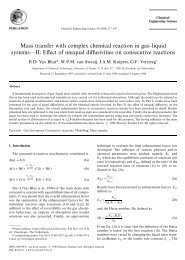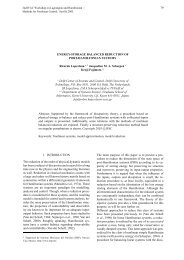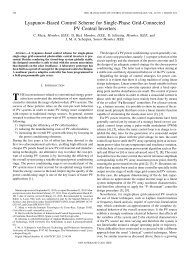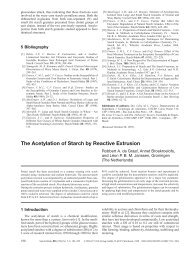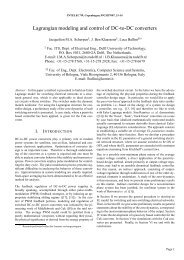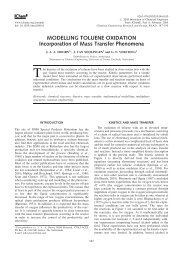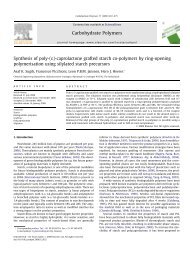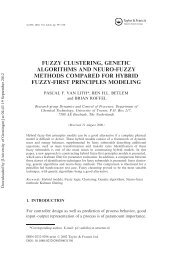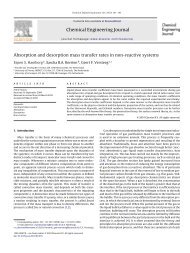Mass transfer with complex chemical reaction in gas—liquid ... - ITM
Mass transfer with complex chemical reaction in gas—liquid ... - ITM
Mass transfer with complex chemical reaction in gas—liquid ... - ITM
You also want an ePaper? Increase the reach of your titles
YUMPU automatically turns print PDFs into web optimized ePapers that Google loves.
122 R.D. Vas Bhat et al./Chemical Eng<strong>in</strong>eer<strong>in</strong>g Science 54 (1999) 121—136side products, thereby complicat<strong>in</strong>g the fundamentalanalysis of such a system. Hence, it was found necessaryto seek model systems <strong>with</strong> a limited number of <strong>reaction</strong>paths. With this, the mass <strong>transfer</strong> phenomena could be<strong>in</strong>vestigated more thoroughly. Inoue and Kobayashi(1968) suggested the use of chlor<strong>in</strong>ation of p-cresol dissolved<strong>in</strong> carbon tetrachloride s<strong>in</strong>ce this system consistsof only two <strong>reaction</strong>s. They also measured rate constantsfor both the <strong>reaction</strong> steps <strong>in</strong>volved. This experimentalsystem was also used by Hashimoto et al. (1968) andTeramoto et al. (1969, 1970), who presented an approximatemethod for estimat<strong>in</strong>g the yield of the <strong>in</strong>termediateproduct at a given <strong>reaction</strong> time. This was validatedexperimentally <strong>with</strong> chlor<strong>in</strong>ation experiments <strong>in</strong> a stirredcell. Further work on the effect of mass <strong>transfer</strong> on theselectivity of the <strong>in</strong>termediate product was done by Pangarkarand Sharma (1974). They derived approximatesolutions for selectivity of the <strong>in</strong>termediate, based on thefilm theory, which were then validated experimentally<strong>with</strong> the chlor<strong>in</strong>ation of p-cresol. Special emphasis wasplaced on the case where depletion of the liquid reactivespecies occurs and for <strong>in</strong>stantaneous consecutive <strong>reaction</strong>.Darde et al. (1983, 1984a, b) <strong>in</strong>corporated the consecutive<strong>reaction</strong> scheme us<strong>in</strong>g the film theory <strong>in</strong>toa model for an ideal CSTR and the results were found toagree <strong>with</strong> experiments on chlor<strong>in</strong>ation of p-cresol carriedout <strong>in</strong> a bubble column (modelled as a cascade ofCSTRs).Some work that had appeared <strong>in</strong> literature was focusedon approximations to determ<strong>in</strong>e selectivity and yield ofthe <strong>in</strong>termediate <strong>with</strong>out actual experimental validation.Kubota and Lee (1973) gave an analytical approximationfor selectivity based on the method of van Krevelen andHoftijzer. Kastánek and Fialová (1982) elaborated thismethod by propos<strong>in</strong>g simple empirical criteria for thesafe application of the approximate solutions and comparedthe analytical approximations <strong>with</strong> numericalsolutions of the film theory. Approximate solutions forthe enhancement factor have been provided by Onda etal. (1970, 1972), who derived semi-analytical solutions forthe film and penetration theory for the case where both<strong>reaction</strong> steps may be considered irreversible. A moredetailed description of the absorption rate for the casepresented by Onda (1970, 1972) was provided byHuang et al. (1980), who presented quantitativevalues of enhancement factors over a range of Hattanumbers us<strong>in</strong>g both film and penetration theory solutions.They observed that the difference <strong>in</strong> the enhancementfactors obta<strong>in</strong>ed from the two theories was alwaysless than 2%.It is only the work of Kuo and Huang (1973) thatstudies the effect of reversibility on consecutive <strong>reaction</strong>s.However, this study was conducted for a simplified <strong>reaction</strong>stoichiometry (see Section 4.4.5). The authorsshowed that the effect of reversibility was to reduce theabsorption rate and, thereby, the enhancement as comparedto the irreversible <strong>reaction</strong> scheme. In the case ofnon-isothermal absorption, an analysis of exothermicirreversible consecutive <strong>reaction</strong> was made by Bhattacharyaet al. (1988). The authors provided approximateanalytical solutions for the <strong>in</strong>terfacial temperature riseand the enhancement factor as a function of the Hattanumber.The limitation of irreversibility of consecutive <strong>reaction</strong>shas been overcome <strong>in</strong> the present study. However,isothermal absorption has still been assumed. The Higbiepenetration theory has been used for this study. Further,an analysis of gas absorption <strong>in</strong>to loaded solutions hasbeen presented. The results obta<strong>in</strong>ed have then beencompared to available literature after mak<strong>in</strong>g necessarysimplifications. For an overview of the exist<strong>in</strong>g literatureon <strong>reaction</strong>s <strong>with</strong> simplified stoichiometries, the reader isreferred to the review by van Swaaij and Versteeg (1992)on the subject. Part I of the study is limited to the case ofequal diffusivities of all <strong>chemical</strong> species <strong>in</strong>volved whereasPart II focuses on the effect of unequal diffusivities onthe absorption rate and its correspond<strong>in</strong>g effect on theoverall enhancement factor.2. Theory2.1. Species conservation equationsThe <strong>reaction</strong> stoichiometry under consideration isgiven by <strong>reaction</strong>s (1a)—(1c). The numerical description,however, considers general stoichiometric and k<strong>in</strong>eticorders of the different <strong>chemical</strong> species.Based on the penetration theory, the unsteady-statespecies conservation equations may be written asAt "D A x !R !R Bt "D B x !R Ct "D C x #R !R Dt "D D x #R Et "D E x #R Ft "D F x #R .(2a)(2b)(2c)(2d)(2e)(2f)It is assumed that the k<strong>in</strong>etic expressions can be describedby simple power-law expressions (3a) and (3b), as



